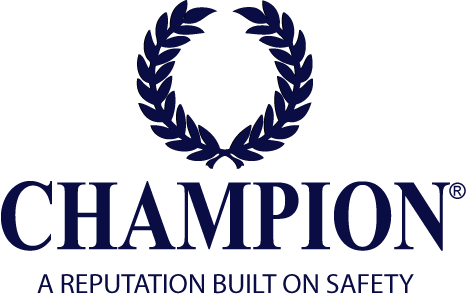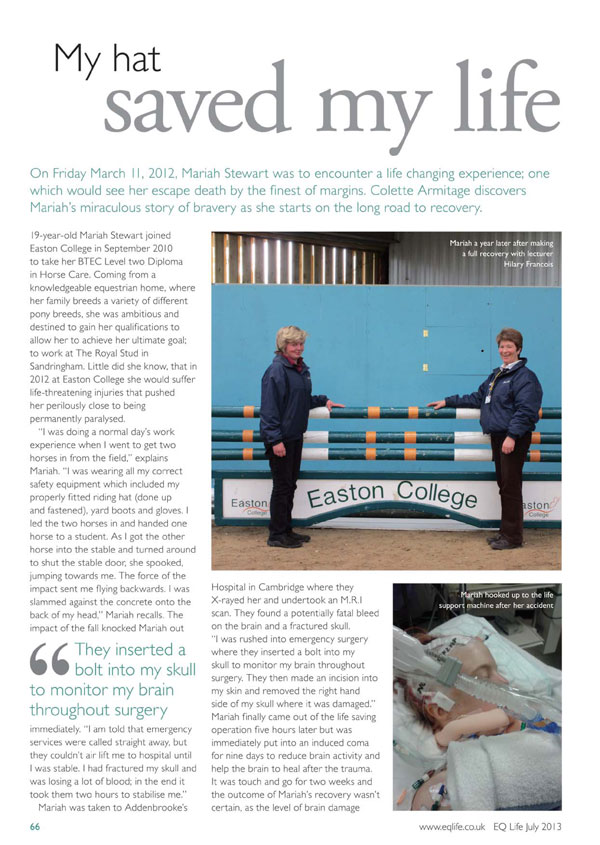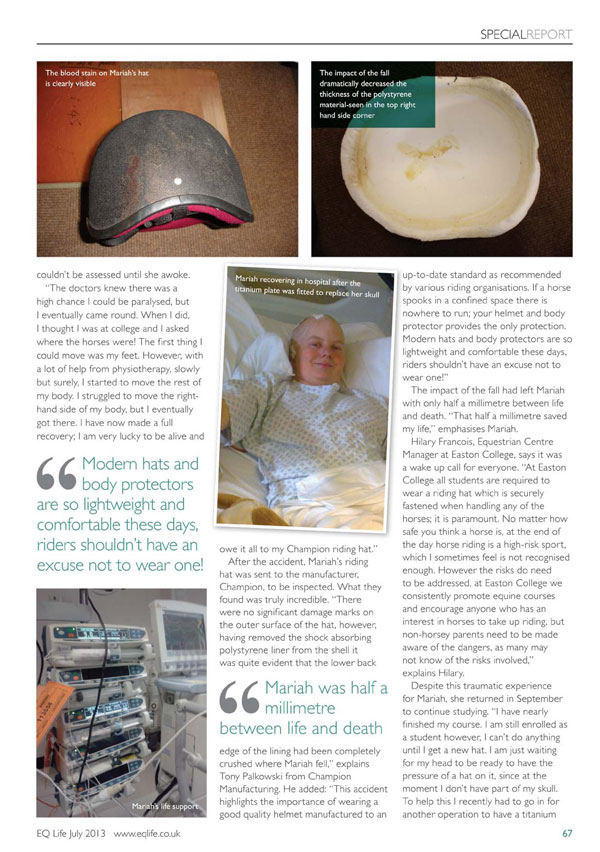On Friday March 11, 2012, Mariah Stewart was to encounter a life changing experience; one which would see her escape death by the finest of margins. Colette Armitage discovers Mariah’s miraculous story of bravery as she starts on the long road to recovery.
19-year-old Mariah Stewart joined Easton College in September 2010 to take her BTEC Level two Diploma in Horse Care. Coming from a knowledgeable equestrian home, where her family breeds a variety of different pony breeds, she was ambitious and destined to gain her qualifications to allow her to achieve her ultimate goal; to work at The Royal Stud in Sandringham. Little did she know, that in 2012 at Easton College she would suffer life-threatening injuries that pushed her perilously close to being permanently paralysed.
“I was doing a normal day’s work experience when I went to get two horses in from the field,” explains Mariah. “I was wearing all my correct safety equipment which included my properly fitted riding hat (done up and fastened), yard boots and gloves. I led the two horses in and handed one horse to a student. As I got the other horse into the stable and turned around to shut the stable door, she spooked, jumping towards me. The force of the impact sent me flying backwards. I was slammed against the concrete onto the back of my head,” Mariah recalls. The impact of the fall knocked Mariah out immediately. “I am told that emergency services were called straight away, but they couldn’t air lift me to hospital until I was stable. I had fractured my skull and was losing a lot of blood; in the end it took them two hours to stabilise me.”
Mariah was taken to Addenbrooke’s Hospital in Cambridge where they X-rayed her and undertook an M.R.I scan. They found a potentially fatal bleed on the brain and a fractured skull. “I was rushed into emergency surgery where they inserted a bolt into my skull to monitor my brain throughout surgery. They then made an incision into my skin and removed the right hand side of my skull where it was damaged.” Mariah finally came out of the life saving operation five hours later but was immediately put into an induced coma for nine days to reduce brain activity and help the brain to heal after the trauma. It was touch and go for two weeks and the outcome of Mariah’s recovery wasn’t certain, as the level of brain damage couldn’t be assessed until she awoke.
“The doctors knew there was a high chance I could be paralysed, but I eventually came round. When I did, I thought I was at college and I asked where the horses were! The first thing I could move was my feet. However, with a lot of help from physiotherapy, slowly but surely, I started to move the rest of my body. I struggled to move the right-hand side of my body, but I eventually got there. I have now made a full recovery; I am very lucky to be alive and owe it all to my Champion riding hat.”
After the accident, Mariah’s riding hat was sent to the manufacturer, Champion, to be inspected. What they found was truly incredible. “There were no significant damage marks on the outer surface of the hat, however, having removed the shock absorbing polystyrene liner from the shell it was quite evident that the lower back edge of the lining had been completely crushed where Mariah fell,” explains Tony Palkowski from Champion Manufacturing. He added: “This accident highlights the importance of wearing a good quality helmet manufactured to an up-to-date standard as recommended by various riding organisations. If a horse spooks in a confined space there is nowhere to run; your helmet and body protector provides the only protection. Modern hats and body protectors are so lightweight and comfortable these days, riders shouldn’t have an excuse not to wear one!”
The impact of the fall had left Mariah with only half a millimetre between life and death. “That half a millimetre saved my life,” emphasises Mariah.
Hilary Francois, Equestrian Centre Manager at Easton College, says it was a wake up call for everyone. “At Easton College all students are required to wear a riding hat which is securely fastened when handling any of the horses; it is paramount. No matter how safe you think a horse is, at the end of the day horse riding is a high-risk sport, which I sometimes feel is not recognised enough. However the risks do need to be addressed, at Easton College we consistently promote equine courses and encourage anyone who has an interest in horses to take up riding, but non-horsey parents need to be made aware of the dangers, as many may not know of the risks involved,” explains Hilary.
Despite this traumatic experience for Mariah, she returned in September to continue studying. “I have nearly finished my course. I am still enrolled as a student however, I can’t do anything until I get a new hat. I am just waiting for my head to be ready to have the pressure of a hat on it, since at the moment I don’t have part of my skull. To help this I recently had to go in for another operation to have a titanium plate fitted. Once I get the all clear I can’t wait to get on with my life, complete my college diploma and then head off to the National Stud to take a degree in breeding. If I have to say one thing about my experience it would be this; wear a hat at all times when you’re around horses. If it wasn’t for my Champion hat, I wouldn’t be here today to tell my story. EQ
Thanks to EQ Life – Your East Anglian Equestrian Magazine – for allowing us to re-publish this article.



